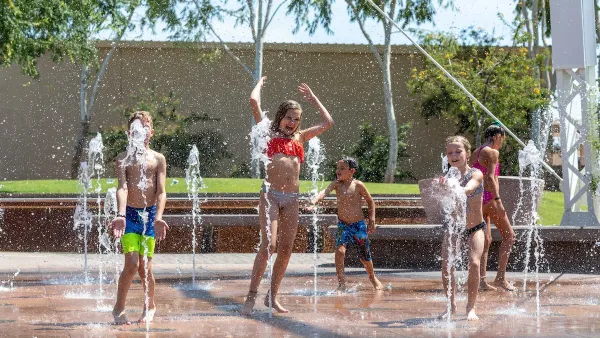Cities can take action to improve conditions during extreme heat events and prevent heat-related deaths, many of which occur in low-income communities.

As cities grow, so does their potential to generate heat, writes Matt Simon. “A city’s roads, buildings, and other infrastructure absorb the sun’s energy, raising temperatures far above those in surrounding rural areas.”
Combined with climate change, this “hyperlocal and erratic” effect, which can vary widely even from house to house, is making it “increasingly difficult to keep vulnerable (and rapidly growing) populations safe during extreme heat events.” As Simon points out, “For example, different kinds of building materials, like brick or wood, absorb and release heat differently. And tall buildings block winds that would otherwise cool a landscape.” Additionally, “This is a problem that doesn’t end when the sun goes down, because the built environment slowly releases its warmth throughout the night, keeping temperatures high.” And “Low-income neighborhoods have it worse, as apartments often lack AC to bring cool air in and proper insulation to keep warm air out. These neighborhoods also have less tree cover, which in richer neighborhoods helps attenuate the heat.”
Edith de Guzman, director and cofounder of the Los Angeles Urban Cooling Collaborative and her colleagues used simulations to assess how heat mitigation measures could improve outcomes in Los Angeles. “They found that making simple tweaks to the built environment, primarily adding trees and painting roofs light colors, would save one in four lives that would normally be lost to heat events.”
Simon asserts that “Perhaps it's time to think of heat as a treatable disease that affects a city, not just its people. Working with community leaders, cities like LA can develop more green spaces, for example,” and implement other strategies to help save lives during the heat waves that are becoming more and more common.
FULL STORY: Extreme Heat Is a Disease for Cities. Treat It That Way

Planetizen Federal Action Tracker
A weekly monitor of how Trump’s orders and actions are impacting planners and planning in America.

Map: Where Senate Republicans Want to Sell Your Public Lands
For public land advocates, the Senate Republicans’ proposal to sell millions of acres of public land in the West is “the biggest fight of their careers.”

Restaurant Patios Were a Pandemic Win — Why Were They so Hard to Keep?
Social distancing requirements and changes in travel patterns prompted cities to pilot new uses for street and sidewalk space. Then it got complicated.

Platform Pilsner: Vancouver Transit Agency Releases... a Beer?
TransLink will receive a portion of every sale of the four-pack.

Toronto Weighs Cheaper Transit, Parking Hikes for Major Events
Special event rates would take effect during large festivals, sports games and concerts to ‘discourage driving, manage congestion and free up space for transit.”

Berlin to Consider Car-Free Zone Larger Than Manhattan
The area bound by the 22-mile Ringbahn would still allow 12 uses of a private automobile per year per person, and several other exemptions.
Urban Design for Planners 1: Software Tools
This six-course series explores essential urban design concepts using open source software and equips planners with the tools they need to participate fully in the urban design process.
Planning for Universal Design
Learn the tools for implementing Universal Design in planning regulations.
Heyer Gruel & Associates PA
JM Goldson LLC
Custer County Colorado
City of Camden Redevelopment Agency
City of Astoria
Transportation Research & Education Center (TREC) at Portland State University
Camden Redevelopment Agency
City of Claremont
Municipality of Princeton (NJ)





























